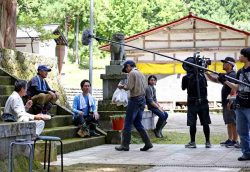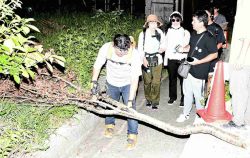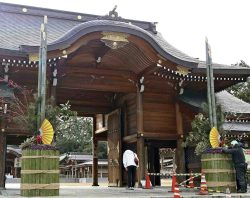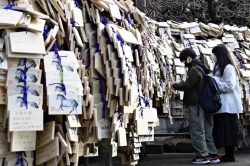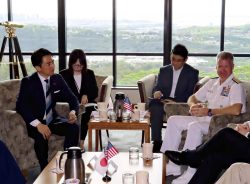Old & New video

People listen to Katsutoshi Hamada, the 12th-generation owner of Edoya, a long-established brush manufacturer and store, in Tokyo’s Chuo Ward on May 26, during the Tokyo Architecture Festival. Visitors removed their shoes to enter the century old Japanese-style building and enjoyed viewing it in small groups.
16:06 JST, June 16, 2024
The Tokyo Architecture Festival, an event that allows the general public to enter notable buildings in central Tokyo, was held mainly on May 25-26. The festival was organized by an executive committee chaired by Prof. Shunsuke Kurakata, an architectural history specialist at Osaka Metropolitan University, under the theme, “Feel the people, know the town through architecture.”
The buildings opened for public visits were 18 structures built in the areas of Nihonbashi-Kyobashi, Ginza-Tsukiji, Otemachi-Marunouchi-Yurakucho and Kanda from the period after the Great Kanto Earthquake in 1923 up until the Japan’s rapid economic growth between the mid-1950s and the early 1970s. With no reservations required and free admission, many of these buildings had long lines of visitors throughout the day.

The front of the Edoya building features a design with six slender, rod-shaped elements that represent brushes.
One of the buildings opened for public viewing was Edoya, a long-established business that has been manufacturing and selling various kinds of brushes since 1718 and is housed in a traditional Japanese-style building. Built in 1924, the two-story wooden building serves both as a shop and residence and is designated as a National Registered Tangible Cultural Property.

People wait in line for a tour of the Nisshokan building in Chuo Ward, Tokyo, on May 26. Standing on what is said to have been the site of a residence of pioneering industrialist Eiichi Shibusawa (1840-1931), the building was constructed in 1928 to house many securities companies.
Normally, only the shop area facing the street is accessible to the general public. However, during the festival, visitors were allowed to enter the inner accounting area in small groups after removing their shoes. There, they could explore the interior while listening to explanations from Katsutoshi Hamada, the 12th-generation president. The event received high praise from the visitors.

This picture taken on May 25 shows many visitors at the wooden structure of Izutsuya in Chuo Ward, Tokyo, which was built in the 1920s and features a fire-resistant copper roof. It was once a sweets shop and has been renovated to be a gallery.
The Mitsukoshi Theater, in a unique location on the sixth floor of the Nihombashi Mitsukoshi Main Store, was opened to the public on May 21. The theater was established in 1927 with the intention of fostering not only an architectural but also a cultural revival after the 1923 earthquake. Although the theater has been largely preserved since its inauguration, it is still used for performances today, so it is normally difficult to enter freely.

Visitors observe the inside of Mitsukoshi Theater in Chuo Ward, Tokyo, on May 21. The theater was built in 1927.
In addition to the opening of the buildings, more than 40 fee-charging guided tours featuring explanations from architects and researchers were also held during the event. Similar architectural events have been held in Osaka and Kyoto, but this is the first time one of this scale has taken place in Tokyo, according to the organizer.
“To have so many people come to see it, the building is the happiest one,” said Rikihiro Kawasaki, the owner of the old Miyawaki building, known as MUSEE GINZA, which was also one of the buildings participating in this special open house.

VVisitors take photos of the VIP room, completed in 1934, at Tsukiji Hongwanji temple in Chuo Ward, Tokyo, on May 25. The room is usually not open to the public.
"JN Specialities" POPULAR ARTICLE
-
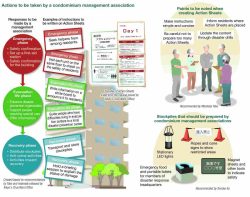
Disaster Preparedness / Apartment Management Associations: Instructions on What to Do in the Event of Power Outage
-
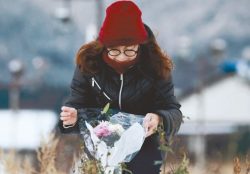
The Japan News / Weekly Edition (1/9-1/15)
-

Kawasaki Releases Guide to Sheltering at Home During Disasters, with Essential Tips for Apartment Residents
-

The Japan News / Weekly Edition (12/19-12/25)
-

The Japan News / Weekly Edition (12/26-1/1)
JN ACCESS RANKING
-

As Chinese Tourists Shun Japan, Hotels and Stores Suffer
-

Core Inflation in Tokyo Slows in December but Stays above BOJ Target
-

BOJ Gov. Ueda: Highly Likely Mechanism for Rising Wages, Prices Will Be Maintained
-

Osaka-Kansai Expo’s Economic Impact Estimated at ¥3.6 Trillion, Takes Actual Visitor Numbers into Account
-

Japan Govt Adopts Measures to Curb Mega Solar Power Plant Projects Amid Environmental Concerns


